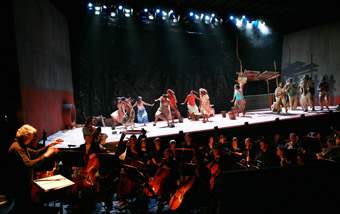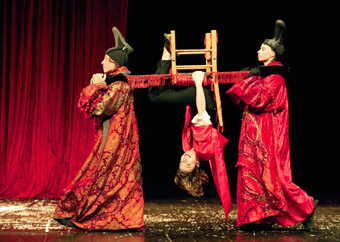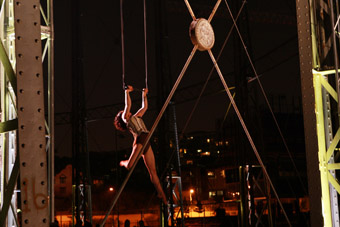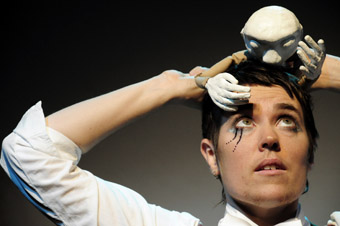art and hope
douglas leonard: 2009 brisbane festival & under the radar

Miracle in Brisbane, Brisbane Festival 2009
photo Atmosphere Photography
Miracle in Brisbane, Brisbane Festival 2009
THIS, IN MY OPINION, WAS ONE OF THE GREAT FESTIVALS, BLENDING IN MEMORY LYNDON TERRACINI’S PREVIOUS FESTIVALS, AND LENDING SIGNIFICANT HINDSIGHT TO HIS CHOICES. CERTAINLY THERE HAVE BEEN THE STANDOUT PRODUCTIONS SUCH AS MABOU MINES’ DOLLHOUSE, THE CONTEMPORARY LEGEND THEATRE OF TAIWAN’S KINGDOM OF DESIRE, DECLAN DONNELLAN’S RUSSIAN LANGUAGE THREE SISTERS, LIZA LIM’S WORLD CLASS OPERAS, YUE LING JIE AND THE NAVIGATOR, AND NOW THIS YEAR’S COMMISSIONED NEW WORK, MIRACLE IN BRISBANE.
Mary Robinson, former President of Ireland (1990-97) and United Nations High Commissioner for Human Rights (1997-2002), was guest speaker with a relevant talk titled “Creating a World without Poverty: Social Business and the Future of Capitalism.” This overarching theme subtly merged with the festival as a whole. Terracini invited us to embark on a narrative journey. In my own case, the import of this journey didn’t strike home until I saw Miracle in Brisbane.
This was a reworking, with director Rhoda Roberts, of his Italian opera Miracle a Milano by composer Giorgio Battistelli. The narrative of a family and the Indigenous community to which they belong who build a shanty town on the fringes of Brisbane forms the bare bones around which this marvellous creature coalesces, and whose protean vigour seemed barely contained. The theatrical focus of the piece pulled in and out, symbolically showing the workings of an inimical white society and the invasion of country, the Stolen Generation and greedy mining moguls. Hope was offered, I think, by the portrayal of Aboriginal society as genuinely inclusive through mixed marriage, and by the notion of Bringing Them Home. The Queensland Orchestra served as a visceral partner to the dramatic surges in this work. Full orchestral expression was counterpointed with solo accordion, didgeridoo and unearthly dissonant choric voices from the Canticum Choir. A small brass band marches on, wet washing is slapped on stage, oil drums are pounded, spears clatter, bodies chant, clap and slap themselves percussively and vocal solos of great power and beauty all precisely and expressively contribute to make the music an equal moiety in this story.

L’Oratorio d’Aurelia
courtesy the artists
L’Oratorio d’Aurelia
L’Oratorio D’Aurelia goes straight to the heart of what our inner child secretly believes, that magic is real and the world is alive. Red velvet stage curtains become lovers, animals, doors and windows; mice catch cats, ice creams are hot, we can fly like kites. This show had the enchantment of fairytale and fable and some of the dark parts too, with a sinister puppet scene in which the protagonist, Aurelia (the performer Aurelia Thiérrée), has her leg gobbled up by a monster and sews it back on. She is at home in her world of infinite possibility which she inhabits with effortless Gallic charm and grace, occasionally connecting with Jaime Martinez for splendidly inventive and acrobatic pas de deux. There is no one story, each scene seems part of a story you half remember and, as in dreams, things simply occur and have their own logic until time reclaims Aurelia and us as she turns to sand and a toy train runs through her stomach and on in a breathtaking illusion which completes the spell.

Chelsea McGuffin, Regarding the Joy of Others, CIRCA
photo Justin Nicholas, Atmosphere Photography
Chelsea McGuffin, Regarding the Joy of Others, CIRCA
CIRCA’s Regarding the Joy of Others, directed by Yaron Lifschitz, might almost have been created from an opposite perspective, playing with the dialectic of the human creature lost in vast outdoor spaces, a familiar Australian scenario. Set in an industrial desert, Brisbane’s century old iconic gasometer was sculpturally lit, from a distance appearing like the bones of a long gone circus. Laser lights played over the interior and travelled out, illuminating the surrounding wasteland and emphasising the isolation. Lawrence English’s spare and lonely soundscape hauntingly reinforced this sense of the spaces between things. We were left to wander through, to immerse ourselves in this severely modernist installation, left as it were to encounter our own estranged, existential selves in an empty universe. We were, after all, back in the European philosophical tradition. Eventually aerialist Chelsea McGuffin performed a solo trapeze act suspended between towering steel frames. She seemed equally self absorbed and vulnerable in her predicament, but as if tentatively experimenting for herself, searching for new possibilities of relationship with the only trace of connection to the world, her trapeze. Her movements, however hesitant or miniscule, added up to an irresistable and courageous visual poetry of longing.
Two Catholic priests and seven of their activist flock stand trial for an act of premeditated civil disobedience, the burning of the files of hundreds of young men eligible for the military draft in the USA in 1968. The Trial of the Catonsville Nine was a seminal moment for the anti-Vietnam war movement in America, but the parallels to our own times and the reasons why The Actors’ Gang has reworked the original 1971 production, with inclusions from the trial transcripts inserted into the original free verse treatment by priest Daniel Brannigan, might appear obvious. However, it ocurred to me that because we have become so accustomed to weasel words, and our whole scale of values so skewed to the economy, how nakedly defenceless such language seems now. Who will dare break the silence? Passionately delivered by this ensemble cast, however, in an elegantly contrived production where the actors fluidly adopt the roles of officers of the court as well as defendants, this work underscored the crying need for an Australian Bill of Rights. I’m also becoming a fan of quality American acting.

Sunny Drake, Other-Wise, Under the Radar
photo Suzon Fuks
Sunny Drake, Other-Wise, Under the Radar
In the Under the Radar program, Otherwise was like one of those collaged images created from hundreds of smaller images, there’s a lot in them and each image is worth a closer look. Sunny Drake’s funny, energetic, poignant and thoughtful show breaks the silence on transgendered people’s history. The intimacy of scale allowed the autobiographical elements of this work to be fully shared. These were often emotionally rich and telling. The show had a carnivalesque brio with clever prop use and well-integrated animation and use of multimedia, but Sunny himself has no actor’s guile, which somehow made him instantly lovable and engaging. While this is one person’s story of exploring what is “minority normal”, to quote Sunny’s father from a segment of Otherwise, this was not navel-gazing but a richly creative engagement with a world where power and sexual or cultural identity are linked.
The matter of silence was given a different twist in another offering from Under the Radar, Cordelia, Mein Kind, a solo performance by Deborah Leiser-Moore. The performer is obsessed by trauma that runs in families, how it silently occupies our bodies, and even invades our dreams. This deeply textured, multilayered and savagely poetical work takes off from Shakespeare’s King Lear, but unravels personal elements of cultural exile and loss. Leiser-Moore’s Yiddish speaking Polish father escaped to Australia from the Holocaust, but left his family behind. However, he never spoke a word to his daughter about his past until she arranged a trip with him back to Poland, which she documents. His favourite film was a Yiddish version of King Lear with a happy ending! The piece abounded with such astounding ironies and coincidences from real life, I was literally rendered speechless.
In an interview in Rave Magazine, Leiser-Moore declared that the elements of visual and physical theatre with which she engages are such a potent force of communication because “[p]eople have their dreaming from that, they have their own imagination, their own stories. You want people to relate it back to their own world.” This festival was a powerful endorsement of Leiser-Moore’s notion. A beautiful essay by Andrea Goldsmith, “Only Connect” (Alan Jacobs ed. Enough Aready: An Anthology of Australian Jewish writing; Allen & Unwin, 1999) describes feelings of cultural alienation in Australia even in a fifth generation Jew. It wasn’t until events like the Hanson phenomenon, the Children Overboard affair, attacks on Native Title and John Howard’s 10-point plan that Goldsmith began to feel Australian, now that she had something to defend. Ultimately it was a trip to Central Australia and Sir Ronald Wilson’s report on the Stolen Generation, Bringing Them Home (1997), that forged for Goldsmith the terrible parallels of European Jewish and Australian Indigenous experience, and of country as a kind of Aboriginal Torah. Goldsmith relates it back to her own world, discovering in the process the possibility of building a tentative new relation with her Australianness.
The European composer Battistelli described Miracle in Brisbane as a form of ‘voiceless’ protest by marginalised people staking claim to their rights in a world that ignores them. This ‘voicelessness’ took a curious turn at an artists’ forum chaired by Sandy McCutcheon. A lively interviewee, the director Rhoda Roberts seemed about to articulate a vision for Australia perhaps less tentative than Goldsmith’s. She appeared to be on the verge of offering us whitefellas a great gift, if only we would accept it. She swallowed her words. Perhaps she felt on this occasion the odds were against her. I hope not.
West End…Live was a four-day event about which I was less sanguine, having been a long time West Ender. Nevertheless, there was a sad authenticity in the private worlds on display at 17 Browning Street, a former boarding house, if the reconstruction of the lives of the poor and desperate can be so construed. However, the main drag on Boundary Street became electric when it hosted on closing night the marchers from the 275 km Cherbourg Walk. Cherbourg was founded as an Aboriginal reserve in the last century, and Boundary Street was named to define a zone of exclusion for Aborigines from the CBD after dusk. This time they marched up the street to applause—a miracle in Brisbane in which we could all participate. And when Kevin Carmody with local and Cherbourg children sang “From Little Things Big Things Grow” a silence that raised the hair on your neck fell on us all. For this moment we were on holy ground, all of us expressing hopes beyond words.
It was also a very moving conclusion to Lyndon Terracini’s grand narrative in Queensland. His tenure here, as director of the Queensland Festival of Music and the Brisbane Festival, has not only overseen an extraordinary expansion in Queensland’s cultural life, but his sense of engagement and democratic outlook has enhanced Queensland’s sense of humanity at large because he has related it so well back to our own world.
2009 Brisbane Festival: Miracle in Brisbane, composer Giorgio Batistelli, director Rhoda Roberts, conductor Luca Pfaff, soundscape/live electronics Davide Tiso, designer Stephen Curtis, lighting design Bernie Tan, The Queensland Orchestra, Canticum Chamber Choir, performers Deborah Mailman, Djakapurra Munyarryun, Tony Briggs, Nicola Raffone, Casey Donovan, Rachael Wallis, Shaun Brown, Rita Pryce, Micqaella Pryce, Cleopatra Pryce, Gina Reuben, Teila Watson, Violet Love, Dwayne Pierce, Andrew Toby, Leeroy Bilney, Jesse Martin, Garret Lyon, Jeremy Robertson, Theodore Cassady, Jermaine Beezley, Judith Wright Centre of Contemporary Arts, Oct 1-3; Compagnie Des Petites Heures, L’Oratorio D’Aurelia, creator,director Victoria Thierrée-Chaplin, performers Aurelia Thierrée Jaime Martinez;Judith Wright Centre of Contemporary Arts, Sep 23-26; CIRCA, Regarding the Joy of Others, director Yaron Lifschitz, performer Chelsea McGuffin, sound artist Lawrence English; Gasworks, Newstead Riverpark, Sep 29-Oct 30; The Actors Gang, The Trial of the Catonsville Nine, writer Daniel Berrigan, director Jon Kellam; Powerhouse Theatre, Sept 24-29; Otherwise, writer, performer Sunny Drake, dramaturg, director Anna Yen, multimedia/animation artists Kate Geck, Ingrid K Brooker, Dana Aleshire, costume/puppet designer, maker Anthea Brescia, set designer Greg Clarke; Under the Radar, Metro Arts, Sep 26-30; Cordelia, Mein Kind, concept, film, co-creator, performer Deborah Leiser-Moore, director, co-creator Meredith Rogers, choreographer Sally Smith; Under the Radar, Metro Arts, Brisbane, Oct 1-3
RealTime issue #94 Dec-Jan 2009 pg. 12






